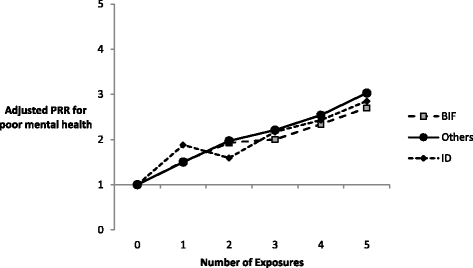The association between employment status and health among British adults with and without intellectual impairments: cross-sectional analyses of a cohort study
- PMID: 29587712
- PMCID: PMC5870818
- DOI: 10.1186/s12889-018-5337-5
The association between employment status and health among British adults with and without intellectual impairments: cross-sectional analyses of a cohort study
Abstract
Background: There exists a well established link between employment status and health, with unemployment being associated with poorer health. Much less is known about the association between economic inactivity and health, especially among people with disabilities. Our aim is to determine whether the association between employment status and health is similar for adults with and adults without intellectual impairment.
Methods: Using nationally representative data from the 1970 British Cohort Study, we undertook a series of cross sectional analyses of the association between employment status and health (self-reported general health, mental health) among British adults with and without intellectual impairments at ages 26, 30, 34, 38 and 42.
Results: People with intellectual disability and borderline intellectual functioning had markedly lower employment rates and poorer health than other participants at all waves of data collection. When compared with participants in full-time employment the prevalence of poorer self rated health and mental health was higher among participants with and without intellectual impairment who were in either part-time employment or were economically inactive at all ages. When compared with participants in employment the prevalence of poorer self rated health and mental health was higher among participants with and without intellectual impairment who were in the economically inactive categories of unemployment, education/training and ill/disabled at all ages. Intellectual disability status appeared to moderate the strength of the relationship between economic activity and self-rated health and, to a much lesser extent, the relationship between economic activity and mental health. In all instances the moderation indicated a stronger association among participants without intellectual impairment.
Conclusions: The results provide substantive evidence to suggest that the nature of the well-established association between employment and better health is similar for British adults with and without intellectual impairments. The results do, however, indicate that the magnitude of the effect involved differed. Further research is needed to identify mechanisms that may underlie this difference.
Keywords: Borderline intellectual functioning; Cognitive ability; Employment; Health; Intellectual disability; Intellectual impairment.
Conflict of interest statement
Ethics approval and consent to participate
NHS Research Ethics Committees ethical approval was sought and granted for BCS70 follow-ups from 2000 on. Available records suggest that only internal university-based ethical review was sought for previous surveys [35]. The datasets analyzed during the current study are available to registered researchers through the UK Data Service repository who gave permission for us to use these data.
Consent for publication
Not applicable
Competing interests
The authors declare that they have no competing interests.
Publisher’s Note
Springer Nature remains neutral with regard to jurisdictional claims in published maps and institutional affiliations.
Figures


Similar articles
-
The association between non-standard employment, job insecurity and health among British adults with and without intellectual impairments: Cohort study.SSM Popul Health. 2018 Feb 6;4:197-205. doi: 10.1016/j.ssmph.2018.02.003. eCollection 2018 Apr. SSM Popul Health. 2018. PMID: 29468188 Free PMC article.
-
The physical health of British adults with intellectual disability: cross sectional study.Int J Equity Health. 2016 Jan 20;15:11. doi: 10.1186/s12939-016-0296-x. Int J Equity Health. 2016. PMID: 26791808 Free PMC article.
-
The Mental Health of British Adults with Intellectual Impairments Living in General Households.J Appl Res Intellect Disabil. 2017 Jan;30(1):188-197. doi: 10.1111/jar.12232. Epub 2015 Dec 9. J Appl Res Intellect Disabil. 2017. PMID: 26647916
-
The association between employment and the health of people with intellectual disabilities: A systematic review.J Appl Res Intellect Disabil. 2019 Nov;32(6):1335-1348. doi: 10.1111/jar.12632. Epub 2019 Jun 10. J Appl Res Intellect Disabil. 2019. PMID: 31180175
-
Health inequalities experienced by children and young people with intellectual disabilities: a review of literature from the United Kingdom.J Intellect Disabil. 2011 Dec;15(4):269-78. doi: 10.1177/1744629511430772. Epub 2011 Nov 30. J Intellect Disabil. 2011. PMID: 22129526 Review.
Cited by
-
Understanding Adaptive Skills in Borderline Intellectual Functioning: A Systematic Review.Eur J Investig Health Psychol Educ. 2025 Mar 20;15(3):40. doi: 10.3390/ejihpe15030040. Eur J Investig Health Psychol Educ. 2025. PMID: 40136779 Free PMC article. Review.
-
Awareness of age-related changes in Norwegian individuals 50+. Short form questionnaire validation.Front Psychiatry. 2022 Nov 10;13:929249. doi: 10.3389/fpsyt.2022.929249. eCollection 2022. Front Psychiatry. 2022. PMID: 36440418 Free PMC article.
-
The relationship between subjective socioeconomic status and health in adults with and without intellectual disability.J Appl Res Intellect Disabil. 2022 Nov;35(6):1390-1402. doi: 10.1111/jar.13028. Epub 2022 Aug 24. J Appl Res Intellect Disabil. 2022. PMID: 36054256 Free PMC article.
-
Association of Borderline Intellectual Functioning and Adverse Childhood Experience with adult psychiatric morbidity. Findings from a British birth cohort.BMC Psychiatry. 2019 Dec 5;19(1):387. doi: 10.1186/s12888-019-2376-0. BMC Psychiatry. 2019. PMID: 31805899 Free PMC article.
-
On-the-job vocational training of nonprofessional ethnic health workers of a primary health care team improves their sense of coherence.Hum Resour Health. 2022 Feb 7;20(1):17. doi: 10.1186/s12960-021-00690-0. Hum Resour Health. 2022. PMID: 35130929 Free PMC article.
References
-
- Avendano M, Berkman LF. Labor markets, employment policies, and health. In: Berkman LF, Kawachi I, Glymour MM, editors. Social Epidemiology. Oxford: Oxford University Press; 2014. pp. 182–233.
-
- Bartley M, Ferrie J, Montgomery SM. Health and labour market disadvantage: unemployment, non-employment, and job insecurity. In: Marmot M, Wilkinson RG, editors. Social determinants of health. Oxford: Oxford University Press; 2006. pp. 78–96.
Publication types
MeSH terms
LinkOut - more resources
Full Text Sources
Other Literature Sources

